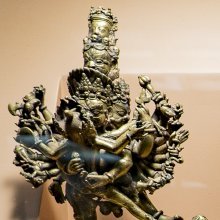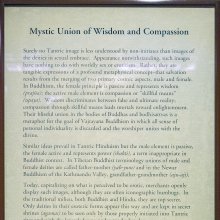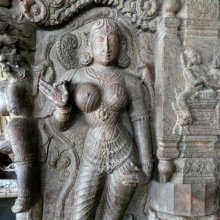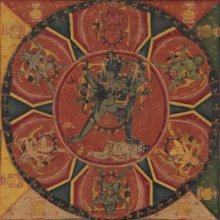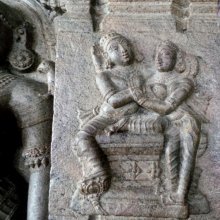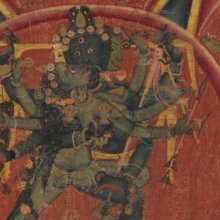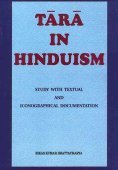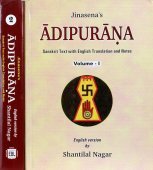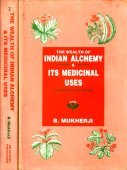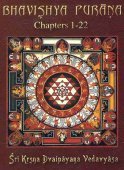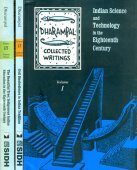Union: 5 definitions
Introduction:
Union means something in Buddhism, Pali, Hinduism, Sanskrit, Hindi. If you want to know the exact meaning, history, etymology or English translation of this term then check out the descriptions on this page. Add your comment or reference to a book if you want to contribute to this summary article.
Images (photo gallery)
(+18 more images available)
In Hinduism
Natyashastra (theatrics and dramaturgy)
Source: Shodhganga: Elements of Art and Architecture in the Trtiyakhanda of the Visnudharmottarapurana (natya)Love in Union is denoted by the Sanskrit term Saṃbhoga and refers to one of the two types of Rati (Erotic Emotion), according to the Viṣṇudharmottarapurāṇa, an ancient Sanskrit text which (being encyclopedic in nature) deals with a variety of cultural topics such as arts, architecture, music, grammar and astronomy.—Śṛṇgāra or the sentiment of love is very important in kāvya specially in dramas. Rati i.e erotic emotion is the sthāyībhāva or permanent feeling of śṛṇgāra. Śyāma i.e dark blue is the colour of this sentiment. Viṣṇu is the God of this sentiment. It is of two kinds viz., saṃbhoga i.e., love in union and viraha i.e., love in separation. The Nāṭyaśāstra also admits it in the same spirit.

Natyashastra (नाट्यशास्त्र, nāṭyaśāstra) refers to both the ancient Indian tradition (shastra) of performing arts, (natya—theatrics, drama, dance, music), as well as the name of a Sanskrit work dealing with these subjects. It also teaches the rules for composing Dramatic plays (nataka), construction and performance of Theater, and Poetic works (kavya).
Yoga (school of philosophy)
Source: ORA: Amanaska (king of all yogas): A Critical Edition and Annotated Translation by Jason BirchUnion (of the individual self with Brahma) is denoted by the Sanskrit term Aikya, according to Divākara’s commentary on the Bodhasāra’s first verse on its section on Rājayoga.—Accordingly, “Rājayoga is the yoga of kings, because rulers can accomplish it even when [they] remain in their position (i.e., as kings). [It is] the yoga associated with [kings] and its [main] characteristic is knowledge concerning the union (aikya) of the individual self with Brahma”.

Yoga is originally considered a branch of Hindu philosophy (astika), but both ancient and modern Yoga combine the physical, mental and spiritual. Yoga teaches various physical techniques also known as āsanas (postures), used for various purposes (eg., meditation, contemplation, relaxation).
In Buddhism
Tibetan Buddhism (Vajrayana or tantric Buddhism)
Source: Google Books: The Crystal Mirror of Philosophical Systems1) Union refers to one of the “Five Stages” (in Tibetan: rim lnga) which represent the completion-stage phases described by the Guhyasamāja Tantric tradition.—Accordingly, [regarding the expanse class of Dzokchen]: This teaching places great importance on the clear light, so it is a bit like the new schools’ teaching of the Five Stages [e.g., union]; its meaning is very different, however. In the teaching of the Five Stages, through the technique by which the Five Winds are bound, you apprehend in its entirety the empty visualized object of meditation, and then, through its subsequent dissolution, you clarify it in the clear light; therefore, there is deliberate activity involved.
2) Union (in Tibetan: kha sbyor) refers to one of the “Seven Integrated Factors” (representing the qualities of the enjoyment body).—Accordingly, [while describing the distinctiveness of the Geluk tradition]: [...] Some say that when the innate gnosis becomes manifest simply through your becoming accustomed to the mind’s abiding in bliss, clarity, and non-conceptuality, then you awaken in this life. There is no awakening, however, without the achievement of a complete enjoyment body possessing the Seven Integrated Factors [e.g., union] and adorned with the major and minor marks. Achieving that in this life is impossible without a cause, and the cause must be of a similar type.

Tibetan Buddhism includes schools such as Nyingma, Kadampa, Kagyu and Gelug. Their primary canon of literature is divided in two broad categories: The Kangyur, which consists of Buddha’s words, and the Tengyur, which includes commentaries from various sources. Esotericism and tantra techniques (vajrayāna) are collected indepently.
Languages of India and abroad
Hindi dictionary
Source: DDSA: A practical Hindi-English dictionaryUnion in Hindi refers in English to:—(nf) a union..—union (यूनियन) is alternatively transliterated as Yūniyana.
...
Nepali dictionary
Source: unoes: Nepali-English DictionaryUnion is another spelling for युनियन [yuniyana].—n. union;
Nepali is the primary language of the Nepalese people counting almost 20 million native speakers. The country of Nepal is situated in the Himalaya mountain range to the north of India.
See also (Relevant definitions)
Query error!
Full-text (+2536): Samyoga, Yoga, Sangama, Samayoga, Maithuna, Sayujya, Samagama, Sandhi, Yoninasa, Mithuna, Shlesha, Samsrishtatva, Sambhoga, Samnipata, Samshlesha, Samyuga, Samsarga, Samagati, Samhati, Samprayoga.
Relevant text
Search found 391 books and stories containing Union, The union; (plurals include: Unions, The unions). You can also click to the full overview containing English textual excerpts. Below are direct links for the most relevant articles:
Sushruta Samhita, Volume 6: Uttara-tantra (by Kaviraj Kunja Lal Bhishagratna)
Chapter II - Pathology of the diseases of the eye-joints < [Canto I - Shalakya-tantra (ears, eyes, nose, mouth and throat)]
Chapter I - Diseases of the eye and its appendages < [Canto I - Shalakya-tantra (ears, eyes, nose, mouth and throat)]
Chapter LXV - The Technical terms used in the treatise < [Canto V - Tantra-bhusana-adhyaya (embellishing chapters)]
Garuda Purana (by Manmatha Nath Dutt)
Chapter CLXXI - The Nidanam of diseases of the eyes < [Dhanvantari Samhita]
Chapter CLXXVIII - The Nidanam of Variola < [Dhanvantari Samhita]
Chapter CLII - The Nidanam of pulmonary consumption < [Dhanvantari Samhita]
Hevajra Tantra (analytical study) (by Seung Ho Nam)
1.3. (iii) The All Pervading Truth Body < [Chapter 3 - Tantric Doctrine in Hevajra Tantra]
5. Vajrayana: A Fusion of Emptiness and Deity Yoga < [Chapter 1 - Tantric Buddhism]
2.2. (ii) Tantric Code Language (sandhya-bhasa) < [Chapter 4 - Tantric Cult in Hevajra Tantra]
Bihar and Eastern Uttar Pradesh (early history) (by Prakash Narayan)
Forms of Marriage and Unions < [Chapter 4 - Social Process, Structures and Reformations]
The Triple Stream < [November 1948]
India and "Federal Union" < [March 1940]
The Union and The States < [January 1951]
Kamashastra Discourse (Life in Ancient India) (by Nidheesh Kannan B.)
2. Works on Kāmaśāstra (l): Anaṅgaraṅga < [Chapter 2 - An Appraisal of Kāmaśāstra Works in Sanskrit]
7. Concept of Kāma (Introduction) < [Chapter 4 - Positioning Kāma among the Puruṣārthas]
3. Tāntric Sexuality < [Chapter 5 - Looking for Alternatives: Possibilities in Kāmaśāstra]
Related products
